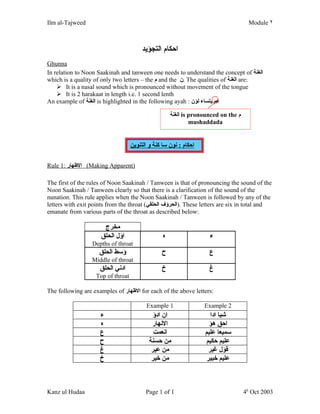Tajweed lesson module 2
- 1. Ilm al-Tajweed Module ŲĒ âŦاØŲاŲ اŲØŠØŽØĪŲØŊ⎠Ghunna In relation to Noon Saakinah and tanween one needs to understand the concept of âŦاŲØšŲØĐ⎠which is a quality of only two letters â the âŦ Ų âŽand the âŦ .ŲâŽThe qualities of âŦ اŲØšŲØĐâŽare: ï It is a nasal sound which is pronounced without movement of the tongue ï It is 2 harakaat in length i.e. 1 second lenth An example of âŦ اŲØšŲØĐâŽis highlighted in the following ayah : âŦØđŲ ŲØŠØģØ§ØĄ ŲØĪŲ⎠âŦ اŲØšŲØĐâŽis pronounced on the âŦŲ ⎠mushaddada âŦاØŲاŲ : ŲŲŲ Øģا ŲŲØĐ Ų اŲØŠŲŲŲŲ⎠Rule 1: âŦ( اŲØļŲØ§ØąâŽMaking Apparent) The first of the rules of Noon Saakinah / Tanween is that of pronouncing the sound of the Noon Saakinah / Tanween clearly so that there is a clarification of the sound of the nunation. This rule applies when the Noon Saakinah / Tanween is followed by any of the letters with exit points from the throat (âŦ .)اŲØØąØĪŲ اŲØŲŲŲâŽThese letters are six in total and emanate from various parts of the throat as described below: âŦŲ ØŪØąØŽâŽ âŦاØĪŲ اŲØŲŲ⎠âŦŲ⎠âŦØĄâŽ Depths of throat âŦØĪØģØ· اŲØŲŲ⎠âŦØ⎠âŦØđ⎠Middle of throat âŦاØŊŲŲ اŲØŲŲ⎠âŦØŪ⎠âŦؚ⎠Top of throat The following are examples of âŦ اŲØļŲØ§ØąâŽfor each of the above letters: Example 1 Example 2 âŦØĄâŽ âŦاŲ اØŊØĪ⎠âŦØīŲا اØŊا⎠âŦŲ⎠âŦاŲŲŲØ§ØąâŽ âŦاØŲ ŲØĪ⎠âŦØđ⎠âŦاŲØđŲ ؊⎠âŦØģŲ ŲØđا ØđŲŲŲ ⎠âŦØ⎠âŦŲ Ų ØØģŲØĐ⎠âŦØđŲŲŲ ØŲŲŲ ⎠âŦؚ⎠âŦŲ Ų ØđŲØąâŽ âŦŲØĪŲ ØšŲØąâŽ âŦØŪ⎠âŦŲ Ų ØŪŲØąâŽ âŦØđŲŲŲ ØŪØĻŲØąâŽ Kanz ul Hudaa Page 1 of 1 4h Oct 2003

